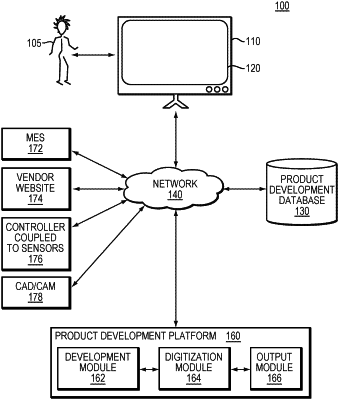| CPC G06Q 10/06393 (2013.01) [G06F 16/288 (2019.01); G06Q 10/067 (2013.01); G06Q 10/0637 (2013.01); G06Q 30/0203 (2013.01)] | 17 Claims |

|
1. A computer-implemented method of developing design of a real-world product using simulation, the method comprising:
identifying a real-world product being developed on a product development platform;
repeatedly evaluating one or more products similar in operation to the identified real-world product, in response to each evaluation:
in response to running tests on the one or more similar products, automatically collecting measurements taken by sensors configured on sub-components of the one or more similar products;
generating simulated operational measurements of the one or more similar products and the sub-components by executing a modeling application to simulate operations of the one or more similar products undergoing a set of operational tests using computer-aided design (CAD) models representing the one or more similar products and the sub-components of the one or more similar products;
determining current performance capabilities of the one or more similar products and the sub-components by applying automated rules to the collected measurements taken by the sensors and the simulated operational measurements generated; and
digitizing the determined current performance capabilities as current benchmark parameters for developing the identified real-world product, the digitizing including: (i) storing the determined current performance capabilities as benchmark parameters in digital form in respective requirements type database components in a central database integrated within the product development platform and (ii) linking, in the central database, the requirements type database components storing the determined current performance capabilities with hardware type database components representing respective products of the one or more similar products, wherein the requirements type components and hardware type components are existing component types of the central database;
generating a data-driven model defining relationships of each current benchmark parameter, wherein for a given current benchmark parameter, each defined relationship includes an attribute representing a value of the given benchmark parameter, the attribute connects the given current benchmark parameter to a product of the one or more similar products in the data-driven model;
generating output, by running an application of the product development platform that searches the current benchmark parameters as stored in the digital form in the requirements type database components in the central database linked to the hardware type database components representing the respective products of the one or more similar products, wherein the searching is based on the generated data-driven model and the searching identifies candidate real-world operational functionalities of the identified real-world product being developed and candidate physical parts of the identified real-world product being developed; and
defining real-world operational functionalities and physical parts of the identified real-world product by invoking the modeling application to: (i) create multiple CAD models each representing the identified real-world product formed of a respective unique configuration of the candidate physical parts, wherein at least one CAD model, of the multiple CAD models, includes at least one of the candidate physical parts with a physical modification, (ii) perform one or more simulations of the identified real-world product performing the identified candidate real-world operational functionalities using the created multiple CAD models, and (iii) select both the real-world operational functionalities and physical parts of the identified real-world product from among the identified candidate real-world operational functionalities, the candidate physical parts, and the at least one of the candidate physical parts with the physical modification, based on results of the performed one or more simulations, thereby developing design of the real-world product,
said identifying a real-world product, repeatedly evaluating, generating output, and defining being performed by a processor.
|